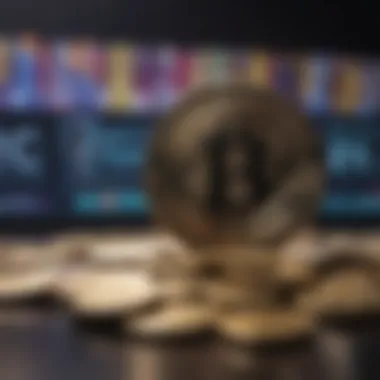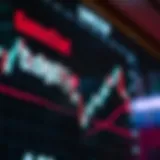Exploring Non-Fungibility in Cryptocurrency


Intro
The landscape of digital assets has undergone a seismic shift in recent years, with non-fungibility standing out as a crucial concept in the cryptocurrency sphere. Unlike fungible tokens, such as Bitcoin or Ethereum, which can be exchanged on a one-to-one basis due to their identical nature, non-fungible tokens (NFTs) represent unique assets that cannot be directly interchanged. This distinction resonates profoundly within the blockchain domain, changing the way we perceive ownership and value.
In this exploration, we will dissect the essence of non-fungibility, delineate its applications, and investigate its influence on the market dynamics of digital goods. It is imperative to understand how non-fungibility shapes our interactions with digital currencies and the broader implications it has for investors and collectors alike. As we progress, we will graph the evolution of NFTs, laying bare their significance in the ongoing digital transformation that is reshaping our economy.
Market Analysis
The cryptocurrency market is a dynamic entity, influenced by myriad factors, including technological advancements, regulatory movements, and market sentiment. The aspect of non-fungibility has become a focal point, particularly with the rise of NFTs, which have carved out a niche in art, music, gaming, and beyond.
Current Trends in Cryptocurrency
To comprehend non-fungibility’s market impact, one must observe current trends.
- Development of marketplaces exclusively for NFTs, such as OpenSea and Rarible, is a testament to the growing demand for unique digital items.
- Mainstream entities, like Twitter and Facebook, have dipped their toes into NFTs, recognizing their potential to reshape digital engagement.
- Increased integration of gaming with NFTs, allowing players to own in-game assets uniquely and trade them on secondary markets.
Rapid adaptation by brands and creators signifies a shift in how digital ownership is viewed. Collectors now see NFTs as valuable assets that hold more than aesthetic quality—they represent a potential investment opportunity.
Price Prediction Techniques
Understanding price movements for NFTs can be tricky, given their unique nature. Traditional valuation methods often fall short; instead, market participants consider factors like rarity, community interest, and historical sales prices. Price prediction may involve several techniques including:
- Trend Analysis: Analyzing past pricing trends for similar assets can provide insights into future behavior.
- Market Sentiment: Gauge the mood of the community through social media platforms, forums, and news to anticipate shifts in demand.
- Scarcity Consideration: The rarity of a digital asset can profoundly influence its value, making it vital to factor this into any predictive models.
As the market mature, sophisticated algorithms and analytics tools are being developed to predict fluctuations more accurately, which in turn is helping investors navigate this emerging marketplace.
Investment Strategies
Navigating the world of non-fungible tokens demands a nuanced approach to investing. With the possibility for substantial returns comes equally pronounced risks, thus requiring astute strategies tailored to individual risk appetites.
Long-Term vs Short-Term Investing
Determining whether to invest in NFTs for the long haul or flip them quickly is pivotal. Here are some considerations:
- Long-Term Investing: Investors may look for great potential in under-valued projects, anticipating significant future appreciation. This approach often suits individuals passionate about certain artwork or creators, lending an emotional connection beyond just financial gain.
- Short-Term Investing: On the other hand, flipping NFTs for quick profits can yield impressive short-term gains, but comes with heightened risk. Success in this area relies on market timing and an acute awareness of current trends.
Risk Management in Crypto Trading
In the volatile realm of cryptocurrency, effective risk management is essential. Strategies include:
- Diversification: By spreading investments across various non-fungible tokens, one can minimize potential losses.
- Position Sizing: Determining how much to invest in each token helps mitigate risks associated with single asset exposure.
- Exit Strategies: Setting profit-taking and stop-loss levels beforehand can prevent emotional trading decisions in the heat of market swings.
A clear strategy combined with disciplined execution can prepare investors for the tumultuous journeys that lie ahead in the world of non-fungibility.
"The only thing that is constant is change." Understanding non-fungibility in cryptocurrency invites one to embrace this change, unveiling new paradigms of ownership and investment.
This narrative offers just a glimpse into the complex realm of non-fungibility within cryptocurrencies. As we further dissect each segment of this topic, the implications of these digital assets will become ever clearer, providing valuable insights to investors, traders, analysts, and tech enthusiasts keen on navigating this evolving landscape.
The Definition of Non-Fungible
In the rapidly evolving cryptocurrency landscape, understanding the term non-fungible is critical. This concept forms the bedrock of unique digital assets, setting it apart from its fungible counterparts, like Bitcoin or dollars. Recognizing non-fungibility illuminates various facets of ownership, value, and scarcity in the digital environment, ultimately guiding investors and enthusiasts in their ventures.
The term non-fungible refers to assets that are unique and cannot be exchanged on a one-to-one basis like dollar bills or cryptocurrencies. Each non-fungible item possesses distinct characteristics, making it irreplaceable. For instance, an original artwork or a specific piece of real estate falls into this category. When it comes to non-fungible tokens, or NFTs, which exemplify this concept, their uniqueness is encoded on a blockchain, providing clear proof of ownership.
The significance of defining non-fungibility lies in how it disrupts traditional notions of value and ownership. Unlike fungible assets, non-fungible assets appeal to collectors and investors seeking rarity and distinctiveness. This aspect is especially relevant today, with digital collectibles gaining increasing popularity. Buyers no longer just seek investments but rather items that carry unique personal or emotional significance. This swelling interest has further ignited the conversation around digital ownership and value.
"Non-fungibility transforms the narrative of ownership from mere possession to a deeper engagement with the asset."
Understanding non-fungibility not only enhances comprehension of the cryptocurrency realm but also assists in navigating the broader implications of a digital economy. As such, distinguishing between fungible and non-fungible assets is essential for anyone involved in this sector, as it affects the strategies they might employ.
Comparing Fungible and Non-Fungible Assets
To further clarify non-fungibility, it helps to juxtapose it against fungibility. The hallmark of fungible assets is their ability to be interchangeable. Whether it’s cash, shares in a company, or cryptocurrencies, units of these assets can be swapped without regard for individual contribution. A classic example is the dollar; one dollar bill is effectively the same as another. On the other hand, an NFT representing a specific digital artwork cannot be easily swapped with another; its identity, metadata, and value are unique to it alone.
In essence, the main differences can be summarised as follows:


- Interchangeability: Fungible assets are easily exchanged, while non-fungible items are one-of-a-kind.
- Value Determination: Fungible assets have a clear market value; non-fungible assets may require subjective assessment.
- Scarcity: Non-fungible items embody rarity often linked to their uniqueness, while fungible goods exist in abundance.
Characteristics of Non-Fungibility
Non-fungible assets exhibit several characteristics that distinguish them in the marketplace.
- Uniqueness: Each non-fungible item is distinct. This uniqueness may derive from its attributes, historical context, or its creator.
- Provenance: Non-fungibility often comes with a detailed history. Ownership can be traced, adding a layer of value that fungible items simply don’t possess.
- Scarcity: Unlike fungible goods, which are produced in abundance, non-fungible assets can be limited in number, creating a sense of rarity and increasing desirability.
- Ownership Rights: Owning a non-fungible token often includes specific rights, such as the ability to sell, display, or use the asset in particular ways, which contributes to a person’s digital identity.
- Transferability: While non-fungible assets are unique, they can still be bought, sold, or traded, but the mechanics behind these transactions differ markedly from fungible assets due to their distinct information.
Historical Context of Non-Fungibility
Understanding non-fungibility cannot be separated from its historical background. The evolution of currency and the value associated with it has paved the way for unique digital assets that we see today in the form of non-fungible tokens. By looking at the past, one can grasp how far we have come in terms of recognizing the importance of unique items and how this concept has transitioned into the digital realm.
Evolution of Currency and Value
Currency has always played a significant role in human transaction history. Initially, trade was constrained to bartering. For instance, a farmer might trade a sack of grain for livestock from a neighbor. These early transactions made it clear that certain items were valued differently based on demand, rarity, and individual worth.
As societies advanced, so did their methods of exchange. Metal coins emerged as a solution, representing fixed values and establishing a standard of trade. Gold coins were exceptionally valued for their scarcity and durability. Fast forward to the 20th century, and we see the rise of fiat money—currency with no intrinsic value but accepted by the government as a means of payment. This evolution demonstrated a significant shift: emphasis was no longer strictly on the physical worth of objects.
The concept of fungibility—where items are interchangeable—became the norm with this fiat system. U.S. dollars, for example, are functionally equivalent; one dollar can be exchanged for another without conflict of value. However, this interchangeability marked a departure from a more unique understanding of items, laying the groundwork for a digital renaissance.
The Rise of Unique Digital Assets
With the advent of the internet, the landscape of value changed once again. The creation of digital currencies like Bitcoin began to challenge traditional financial systems. While Bitcoin is a fungible asset (one Bitcoin equals another), it ignited a discussion about uniqueness in the digital sphere. What about assets that are not interchangeable? This question leads to the rise of non-fungible tokens, or NFTs, that assert individuality and authenticity in a world flooded with copies.
NFTs emerged from this digital transformation, representing one-of-a-kind items on blockchain technology. For instance, a digital artwork sold as an NFT can be traced back to its creator, establishing a sense of ownership and provenance absent in traditional digital formats. This shift directly reflects the human inclination toward value—value tied not just to the item itself but to its story, originality, and scarcity.
"As we explore the evolution of currency, we see how the perception of value evolves with societal changes, carving the path for non-fungible assets in the digital era."
Non-Fungible Tokens Explained
Non-fungible tokens, or NFTs, represent a watershed moment in the landscape of digital assets. Their importance cannot be overstated, particularly in how they reshape ownership and value perception in the cryptocurrency space. Unlike fungible assets, which can be exchanged for one another—think of a dollar bill or a standard cryptocurrency—NFTs are unique. Each token carries distinct information and serves a particular purpose. This uniqueness underlies their value and provides a wealth of opportunities for artists, collectors, and investors alike.
Prologue to NFTs
So, what exactly is an NFT? Simply put, a non-fungible token is a digital certificate of ownership that is stored on a blockchain. Behind the scenes, this is managed via smart contracts that enforce the uniqueness of each digital item. The most common platform for NFTs is the Ethereum blockchain, although others like Binance Smart Chain and Flow are also available. It isn't merely the technical aspect that gives NFTs their allure; it's what they can do for individuals and communities.
Consider the realm of digital art, for example. Traditionally, artists faced challenges in proving ownership of their work in the vast, often chaotic online landscape. An artwork could be easily replicated, making it tricky to claim originality. With NFTs, artists can tokenize their creations, allowing them to sell their work as verified digital assets. This new ownership model not only empowers creators but also fosters a deeper appreciation among collectors.
Benefits of NFTs
- Ownership Verification: Buyers have clear proof of ownership, which reduces fraud.
- Royalties for Artists: Smart contracts can be programmed to ensure artists earn a percentage of sales every time their work resells.
- Access to a Global Market: With the rise of digital marketplaces, artists can reach buyers worldwide without intermediaries.
- Community Engagement: NFTs can create a community around art and collectibles, promoting interaction between creators and fans.
How NFTs Work
Getting to grips with how NFTs function can feel a bit like diving into the deep end, but it’s crucial for understanding their potential. At their core, NFTs utilize blockchain technology, ensuring each transaction is recorded and verifiable. When someone purchases an NFT, they're not just buying a piece of art or a collectible; they're acquiring a digital asset that signifies ownership.
The Structure of an NFT
An NFT consists of:
- Metadata: Information describing the asset, such as title, creator, and a link to the original digital file or object.
- Smart Contracts: Code on the blockchain that governs how the NFT behaves, such as transferability and resale royalties.
- Unique Token ID: Each NFT has a distinct identification number that distinguishes it from all others.
Here’s a simplified process of how NFTs work:
- Creation: An artist or creator produces a digital file (artwork, music, etc.), then mints it into an NFT via a marketplace like OpenSea or Rarible.
- Tokenization: The digital file is encoded as a unique token on the blockchain, complete with all relevant information.
- Sale: A buyer purchases the NFT. The transaction is recorded, and ownership is transferred, while the original creator may receive a predefined royalty.
- Trading: The new owner can choose to hold or resell the NFT, with each transaction also logged on the blockchain for full transparency.
"NFTs open up a universe of possibilities where creators can engage directly with their audiences."
Market Dynamics of Non-Fungible Tokens
The realm of non-fungible tokens (NFTs) is increasingly recognized not just for its unique digital assets but also for the vibrancy of its surrounding market dynamics. Understanding these dynamics is crucial as they inform how NFTs are being valued, traded, and perceived within the wider economic ecosystem. The market for NFTs operates as a confluence of technology, art, culture, and investment, making it both fascinating and complex.
Valuation Mechanisms of NFTs
Valuating NFTs is no walk in the park, primarily due to their inherent uniqueness. Traditional methods of valuation, which often lean heavily on comparable sales and established pricing norms, fall short in the context of non-fungible tokens. For instance, two digital artworks may share similar styles or themes, yet their perceived value can diverge significantly based on factors such as the artist’s reputation, historical significance, and even the story behind the piece.


- Market Comparables: Buyers frequently look at past sales for similar items to gauge value. However, unlike houses or stocks, each NFT's individuality makes direct comparables difficult.
- Scarcity and Demand: Scarcity plays a vital role, as tokens that are rare or are part of esteemed collections command significantly higher prices. The classic case of this is Beeple's digital piece that sold for a staggering $69 million at auction.
- Utility: Some NFTs provide added functionality, like access to experiences or exclusive content. This utility can influence how much someone is willing to pay, impacting overall valuation.
Moreover, emotions and community sentiment can considerably dictate valuations. The rise and fall of interest in particular NFT artworks or collections can lead to unexpected surges in prices, akin to a roller coaster. As a result, investors often employ a mix of research, intuition, and market sentiment to guide their buying decisions.
Trends and Growth within the NFT Market
In recent years, the NFT market has undergone explosive growth, evolving rapidly to become a significant component of the digital economy. Not only has this been driven by technological advancements but also by shifts in consumer behavior, cultural engagement, and market demand. Let’s take a look at some essential trends:
- Mainstream Adoption: Once viewed as a niche interest, NFTs are now being embraced by celebrities, brands, and even industries like gaming and real estate, boosting general awareness and legitimacy.
- Diversity of Use Cases: We're seeing NFTs stretching well beyond digital art. From virtual real estate in platforms like Decentraland to music rights and virtual fashion, the applications are boundless, leading to a broader and more engaged market.
- Environmental Concerns: The energy consumption associated with some blockchain technologies has led many users and creators to explore more environmentally friendly alternatives. This slight shift hints at a future where sustainability could dictate market preference and structure.
- Speculative Behavior: While the NFT market has attracted serious collectors, it has also seen its share of speculation. This trend can create volatile swings in prices and contribute to a sense of urgency for buyers to jump in and out of the market.
As we peer into the future, it becomes evident that the dynamics of the NFT market are constantly evolving. The interplay between innovation, user engagement, and regulatory considerations could transform how NFTs are perceived and valued in the years to come.
The NFT market may be volatile, but its vibrancy offers unparalleled opportunities for expression, ownership, and community building.
Applications of Non-Fungibility
The domain of non-fungibility has found a multitude of applications within various sectors, each showcasing its potential and transformative power. Understanding these applications can help elucidate the significance of unique digital assets in our economy today. Non-fungibility lends itself not only to artistic endeavors but also to diverse fields such as gaming and real estate, where traditional paradigms of ownership are being reexamined. Here, we will delve into three prominent applications: art and digital collectibles, gaming and virtual realities, and real estate and property rights.
Art and Digital Collectibles
In the art world, non-fungibility has become a revolutionary concept. Artists and collectors alike are swimming in a new ocean of opportunities. Non-fungible tokens (NFTs) have emerged as a novel medium for digital art, offering artists a way to tokenize their work, thus providing proof of authenticity and ownership.
This shift allows creators to sell their art directly to consumers without the need for intermediaries, disrupting traditional gallery-centric models. For example, the artwork titled "Everydays: The First 5000 Days" by Beeple was sold for a staggering $69 million at a Christie's auction. This sale illustrates not only high valuation but also a cultural shift in perceptions of art.
Moreover, collectors can now buy, sell, or trade digital art securely on blockchain platforms. This provenance ensures that the unique essence of each piece is maintained. Digital collectibles, such as those seen in platforms like Sorare, where soccer fans can own unique digital player cards, further entrench non-fungibility in the cultural psyche.
Gaming and Virtual Realities
Gaming is another arena where non-fungibility is making waves. The integration of NFTs into gaming allows players to possess unique in-game assets that carry real-world value. Elements like skins, characters, and virtual lands can be tokenized, creating a sense of ownership previously unseen in traditional games.
Consider the game Axie Infinity, where players breed and battle digital creatures called Axies. These creatures can be bought and sold as NFTs, rewarding players with potential profits for their time spent in the game. Moreover, players gain a deeper emotional connection to their assets, as each Axie possesses unique traits and abilities that can affect gameplay.
Additionally, virtual worlds, such as Decentraland and The Sandbox, provide a space for users to own digital real estate, where the plot of land or structures can be bought, sold, or developed. This paradigm blurs the lines between traditional gaming experiences and tangible investments, giving players a stake in a virtual economy.
Real Estate and Property Rights
When it comes to real estate, non-fungibility takes on yet another significant role. The concept of tokenizing property rights through blockchain technology is gaining traction. Imagine fractional ownership of a luxury apartment in a prime location—the use of NFTs can facilitate this by representing a share of the property on the blockchain.
This method could democratize investment in real estate, allowing a broader audience to partake in ownership without needing vast sums upfront. It’s an opportunity for many to invest in assets that were traditionally reserved for the wealthy. Furthermore, it provides clarity and transparency in legal documents, as all ownership details are publicly verifiable and immutable.
"Tokenization of real estate can streamline sales and improve liquidity, offering a fresh alternative to traditional investing approaches."
However, there are challenges to consider, including regulatory hurdles and a need for widespread adoption. Yet, the potential impact of non-fungibility on real estate cannot be overstated, as it promises a more flexible and inclusive market.
Legal Considerations Surrounding Non-Fungibility
The realm of non-fungible tokens (NFTs) and unique digital assets brings forth a host of legal considerations that cannot be overlooked. From intellectual property rights to the processes of ownership and transfer, understanding these legal facets is not just beneficial—it is essential. Without a firm grasp on the underlying legal principles, both creators and collectors can find themselves tangled in a web of disputes or unforeseen liabilities.
Intellectual Property Issues
Intellectual property (IP) constitutes a vital area of concern within the landscape of non-fungibility. NFTs often represent digital art, collectibles, or original works that carry inherent creative value. However, the ownership of an NFT does not automatically confer full IP rights to the buyer. This can lead to misconceptions among collectors about what they actually own.
- Copyright vs. Ownership: When a digital art piece is minted as an NFT, the creator typically retains copyright unless explicitly transferred. This distinction can get tricky when artists sell their work as NFTs; buyers may assume they have complete rights to reproduce or distribute the artwork, when in fact, that’s not the case without a proper agreement.
- Licensing Agreements: To clarify rights, it's advisable that creators and buyers enter into clear licensing agreements at the point of sale. This could dictate whether the buyer can display the NFT publicly or create derivative works, thus safeguarding the creator’s interests while outlining buyers' entitlements.
This gray area creates opportunities for disputes, particularly when an artist's work is used in ways not intended by the creator. With the market rife for exploitation, understanding intellectual property rights remains key for minimizing legal risks.
"The NFT marketplace should not just be a free-for-all; it ought to foster a respect for the creator's rights."
Ownership and Transfer of NFTs
Ownership of NFTs is another significant legal aspect which requires meticulous attention. Unlike traditional assets, digital tokens operate on blockchain technology, which offers a transparent yet complex ownership structure.
- Blockchain Ledger: Each NFT's ownership is recorded on a blockchain, which provides a verifiable history of who owns a token. This technological underpinning ensures that once an NFT is sold, the transaction is immutable and can be traced back to the original creator.
- Transfer Protocols: The ease with which NFTs can be transferred across wallets or platforms raises questions related to regulatory compliance. Some jurisdictions may have specific laws governing the buying, selling, and trading of digital assets. Failing to adhere to these laws when transferring NFTs could lead to legal ramifications.
- Fraud and Scam Risks: As the surge of interest in NFTs continues, so does the potential for fraud. Fake platforms or counterfeit NFTs can lead to significant financial losses for unsuspecting buyers. Awareness of the legal protections, such as consumer rights and fraud prevention measures, is critical for any investor involved in NFT transactions.
Therefore, navigating the minefield of ownership and transfers necessitates a blend of legal insight and technological understanding. It’s vital for both creators and collectors to remain informed and cautious, ensuring not just artistry thrives but also legal frameworks protect their endeavors.


Challenges and Criticisms of Non-Fungible Tokens
The discussion surrounding non-fungible tokens (NFTs) is not all rainbows and roses. While they have captured the imaginations of many, significant challenges and criticisms are bubbling beneath the surface. Understanding these concerns is crucial to making informed decisions within this market. If one is to navigate through the digital landscape effectively, a solid grasp of these pitfalls can enable investors and enthusiasts to sidestep potential disaster and spot valuable opportunities.
Environmental Concerns
One of the hottest potatoes in the conversation about NFTs is their environmental impact, particularly linked to their creation and transactions. Most NFTs are minted on the Ethereum blockchain, which employs a proof-of-work consensus. This method is notorious for demanding substantial computational power, leading to a hefty carbon footprint.
"As we increasingly dive into digital innovation, we must not forget the footprints we leave behind on our olive planet."
In clear terms, the energy consumption tied to creating and trading these tokens can be compared to the energy usage of entire countries. It’s a gut punch for environmentally-conscious collectors and critics alike.
Some alternatives are beginning to sprout up — blockchains using proof-of-stake or other less energy-intensive methods are coming into play. These options aim to balance the need for innovative technology with sustainability. However, the transition remains slow, and skepticism lingers about whether these greener solutions can gain enough traction.
Market Speculation and Volatility
Looking beyond environmental aspects, the NFT market is a veritable roller coaster of speculation. Prices can swing wildly, often driven by investor sentiment rather than intrinsic value. Stories abound of digital art pieces selling for millions, only to plummet in value shortly after. This volatility can make the market appear akin to a casino more than a stable investment platform.
Investors should weigh risks carefully. Here, some critical questions come to mind:
- Is the asset truly unique, or is it just another fad?
- What happens when demand dwindles?
- Are buyers chasing hype rather than real value?
This speculative nature raises doubts over the long-term viability of many NFTs. Caution is the name of the game; informed decisions need to be coupled with a clear understanding that today’s hot asset might be tomorrow’s invisible relic.
In summary, while non-fungible tokens represent a fascinating shift in the digital asset landscape, the environmental implications and market volatility demand serious contemplation. By grasping these multifaceted challenges, potential investors and enthusiasts can better prepare themselves for the unpredictable journey ahead.
Future Prospects of Non-Fungibility
As we peer into the crystal ball of the digital landscape, the future prospects of non-fungibility seem quite promising. This rapidly evolving space offers not only a shift in how value is perceived and transferred but also opens the door to innovative applications that could redefine traditional concepts of ownership and uniqueness in digital assets. The incorporation of non-fungible tokens (NFTs) into various facets of our lives indicates their growing importance in both the financial and technological arenas.
Integrating Non-Fungibility in Emerging Technologies
The integration of non-fungibility in emerging technologies marks a watershed moment for how digital assets are created, traded, and perceived. Non-fungible tokens harness blockchain's unique characteristics to provide proof of ownership, transparency, and authenticity. As new technologies like virtual reality (VR) and augmented reality (AR) sweep through various industries, non-fungible items can enhance immersive experiences.
Imagine attending a virtual concert where the digital ticket you purchased is an NFT that offers you exclusive backstage access. Unlike conventional tickets, which can be printed and be the same as any other, this NFT holds a specific value tied to the experience. This idea could expand beyond entertainment to areas like education, where unique digital credentials can signify achievement or mastery in a more secure way than traditional diplomas.
"In the ever-evolving landscape of digital assets, non-fungibility is transforming how we think about ownership and value, creating opportunities for personalization and exclusivity."
The potential applications for non-fungibility stretch far and wide, with sectors such as real estate considering tokenization. Properties can be represented as unique digital assets on a blockchain, allowing for fractional ownership or easier transfers. This could not only democratize access to real estate investing but also increase liquidity in a traditionally illiquid market.
Innovations on the Horizon
Looking ahead, the innovations in the realm of non-fungibility seem expansive. From new standards in token creation to novel methods of adding value, the landscape is ripe for disruption. Protocols that enhance interoperability between different blockchains promise to simplify the transactions of non-fungible tokens, offering users seamless experiences across platforms.
Moreover, the rise of generative art, where unique pieces are algorithmically created, is drawing attention. Artists can leverage blockchains to mint artwork as NFTs that are genuinely one-of-a-kind, enriching the art market's diversity and accessibility. The appeal in owning a digital piece that is entrenched in technology adds layers of intrigue—it's not just art but an investment in innovation.
Additionally, governance models using non-fungible tokens are emerging as a way to provide voting rights or decision-making power within decentralized organizations. By tying certain rights to NFTs, communities can ensure a transparent and democratic process of governance that reflects the compositions of those invested.
Simply put, the future of non-fungibility teems with possibilities. As innovative technologies converge with non-fungible assets, we are bound to witness a transformation that redefines value, broadens accessibility, and dismantles conventional barriers. The journey has just begun, and those who keep their ears to the ground will reap the benefits that non-fungibility has in store.
End: The Significance of Non-Fungibility
The notion of non-fungibility stands central to understanding the dynamics of the digital asset landscape. As this article has explored, non-fungibility makes a clear distinction between unique items and those that can be exchanged directly for one another, like currency. This has profound implications in a world increasingly leaning toward digital interactions. With the transformative emergence of NFTs, the significance of non-fungibility becomes even clearer—not merely as a concept but as a powerful tool to redefine ownership, value, and authenticity.
Understanding non-fungibility allows investors and traders to grasp the underpinnings of market behaviors. It's not just about buying and selling; it's about recognizing what differentiates digital assets in terms of perception and valuation. For example, a digital artwork like Beeple’s "Everydays: The First 5000 Days" sold for $69 million, highlighting how a unique digital item can carry immeasurable value far beyond its mere bytes. This teaches investors that uniqueness amplifies desirability, leading to potentially lucrative investments.
Moreover, the implications stretch beyond creative domains into practical realms, like real estate and intellectual property. Non-fungibility enables transparent ownership transfers and verifiable authenticity, which are crucial in sectors prone to fraud and misrepresentation. As our discussion has shown, owning a unique digital asset galvanizes trust and transparency in transactions, aspects that cannot be overstated in today’s digital economy.
"Non-fungibility is not merely a feature of blockchain; it's a new paradigm of ownership itself."
Reflecting on the Impact of Non-Fungibility
The advent of non-fungible tokens has crafted a new lens through which both casual users and professional collectors view digital ownership. This phenomenon goes beyond mere recognition of asset differences; it actively shapes societal perceptions of value in intangible realms. We’re witnessing the birth of a culture where digital items—not just physical assets—can gain significant cultural and economic milestones.
Non-fungibility introduces a fresh framework that empowers creators. Artists now find themselves with more control over their work and profits, bypassing traditional gatekeepers of the art world. This development fosters a direct link between creator and consumer, building communities around unique pieces instead of generic products. Not only does this alter income distribution, but it also elevates the cultural narrative surrounding what it means to own a piece of art, creating a rich tapestry of engagement.
The Ongoing Evolution of Digital Assets
As we look toward the horizon, digital assets will continually evolve, influenced by technological advancements and shifts in consumer behavior. The primary drivers are likely to include the integration of augmented reality (AR) and virtual reality (VR) into the NFT space. Imagine attending a virtual art gallery showcasing unique digital art and interacting with them in real-time, every pixel breathing creativity. Such experiences underscore the potential of non-fungible tokens to transform art consumption.
Furthermore, challenges remain that could affect their evolution, such as regulatory scrutiny and concerns over the environmental impact of blockchain technology. Policymakers grapple with how to govern an evolving digital landscape that defies conventional classifications. Regardless, the trajectory seems firmly set in favor of non-fungible assets reshaping transactions in unprecedented manners.
In summary, embracing non-fungibility opens the door to innovations in ownership, authenticity, and community engagement—elements that are becoming indispensable in today’s digital ecosystem.















